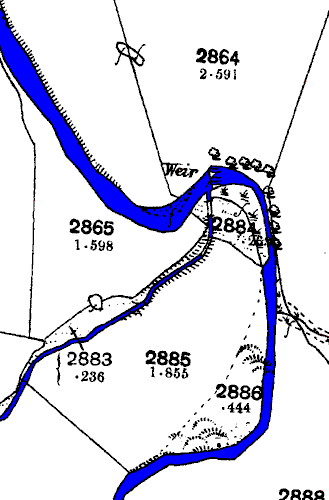Conjectured Paper Mill

From 1868 O/S Plan XVI.11
IAIoM places the conjectured position of earliest recorded
Paper Mill in field 2864 or close to it - however this is not consistent
with the petition of Margaret
Quayle who states 2 mill races and the river ran close together
in her husband's land. This would suggest that the paper mill was south
of the weir, that the tuck mill originally used the long established
race to Castletown Mill shown flowing (N-S)
to the west of the river but that the water supply was insufficient
and an additional race was cut - thus my suggestion is field 2885, 2882
or 2921 or even 2920 which lie to the south above the sluice from the
dam for Castletown Mill and between the mill race and the river (the
size of these fields amounts to a little over 12 ac which is very close
to that sold in 1797. But as IAIoM, writing in 1971, states "the
course of the river has been considerably altered in the last 150 years
and the area disturbed by the building of the railway .. all the original
buildings had been destroyed by the Quayle family's early nineteenth
century agricultural improvements" all of which makes it near impossible
to determine its position.
|
|
William Cubbon in his study of Manx Paper Makers states:
Apart from a solitary tantalising reference in the Liber Cur. Monaster
(1696 to 1805) to a 'Tuck Mill or Paper Mill road through Whitestone 1,
the earliest information we have concerning the insular manufacture of paper
is contained in the 'Report of the Commissioners of Inquiry for the Isle of
Man,' published in 1792.
His footnote gives a little more information
1 Ballawhetstone, near Billown, Kirk Malew. There is a record for the year
1797 of the sale of a Paper Mill at Ballasalla, by Charles Moore of Billown
to George Quayle of Castletown, with lands of eleven acres, but this is the
only indication we are able to trace other than the one quoted that a paper-mill
existed in the eighteenth century in Kirk Malew. What is undoubtedly the same
property is described in the 1703 Manorial Roll as follows:-
' Capn Cha. Moore for a Tuck Mill and a Croft now a Small meadow of 10s.
4d. rent compounded for in . . by . . . ffine then . . . .
The blanks are an indication that there appeared to be no entry in the 1643
or later composition books.
The 1797 sale is that found in SSS Oct 1798 33 and summarised as
dated 18 Jul 1797;Charles Moore(Malew) + wife Elizabeth als Clucas sell for
£387 5s(British) to George Quayle(Castletown) that mill known as the
paper mill + dwelling house + lands(11A 3r 34p) adj John Taubman on south,
Wm Leece on west and sd George Quayle on north + east - condition that George
Quayle not to erect any corn or flax mill or to convert existing building
to such and not take from the ancient mill race belonging to Castletown mill
any of the water so as to injure it + that Charles Moore + proprietors of
Castletown mill have the right to repair the dam head; Witt James Oates, Philip
Oates, Wm Kirwan, Edwd Gelling
There is however a petition presented
in late 1764 by Margaret Quayle, wife of the temporarily absent John Quayle
Clerk of the Rolls, which suggests that the feed was taken from the same weir
that fed the long mill race to Castletown mill and that the tail race was into
the nearby Silverburn - both mill races and the river flowing through the Creggans
estate part of which land was low lying - the river and races being constrained
by embankments to prevent flooding.
The conversion of the tuck mill to a paper mill would correspond with the arrival
of a Mr McDaniel from Ireland to run a paper mill.
References
[IAIoM]T.A.Bawden, L.S. Garrad, et al The Industrial Archaeology of the
Isle of Man Newton Abbot: David & Charles 1972 (ISBN 0-7153-5440-X)

